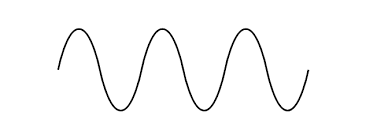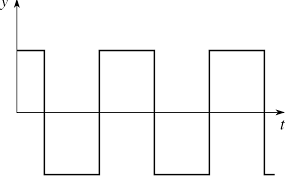Fourier Series and Transform: Difference between revisions
No edit summary |
No edit summary |
||
| Line 4: | Line 4: | ||
[[File:sinewave.png|400px|]][[File:Arrow.png|200px|]][[File:squarewave.png|300px|]]<br> | [[File:sinewave.png|400px|]][[File:Arrow.png|200px|]][[File:squarewave.png|300px|]]<br> | ||
As the diagram hints, we can use the Fourier Series to get from the sine wave to the square wave. Consider this progression of solely sine functions. We know what <math>f(x)=\sin(x)</math> looks like. If we keep adding a term in the partial sum for all odd integers of <math>f(x)=\frac{\sin(nx)}{n}</math>, the development of the square wave is noticeable as n increases: | As the diagram hints, we can use the Fourier Series to get from the sine wave to the square wave. Consider this progression of solely sine functions. We know what <math>f(x)=\sin(x)</math> looks like. If we keep adding a term in the partial sum for all odd integers of <math>f(x)=\frac{\sin(nx)}{n}</math>, the development of the square wave is noticeable as n increases: | ||
[[File: | [[File:Asdf12.png|300px|]] | ||
Revision as of 00:38, 6 December 2022
A Fourier series is an expansion of trigonometric functions to model periodic functions. This method proves useful in the study of harmonic systems as the analysis in a more familiar domain is much simpler than in its original domain. It has a variety of applications ranging from signal processing to quantum mechanics. The Fourier Series is defined as:
[math]\displaystyle{ f(x)=\sum_{n=1}^{\infty}{a_n\cos{(\frac{nx}{L}})}+\sum_{n=1}^{\infty}{b_n\sin{(\frac{nx}{L}})} }[/math]
Intuition
Many physical systems can be modeled by square waves. Consider systems with on-off behavior, similar to an on-and-off switch. A sine wave and square wave looks like this respectively:



As the diagram hints, we can use the Fourier Series to get from the sine wave to the square wave. Consider this progression of solely sine functions. We know what [math]\displaystyle{ f(x)=\sin(x) }[/math] looks like. If we keep adding a term in the partial sum for all odd integers of [math]\displaystyle{ f(x)=\frac{\sin(nx)}{n} }[/math], the development of the square wave is noticeable as n increases:
Error creating thumbnail: sh: /usr/bin/convert: No such file or directory Error code: 127